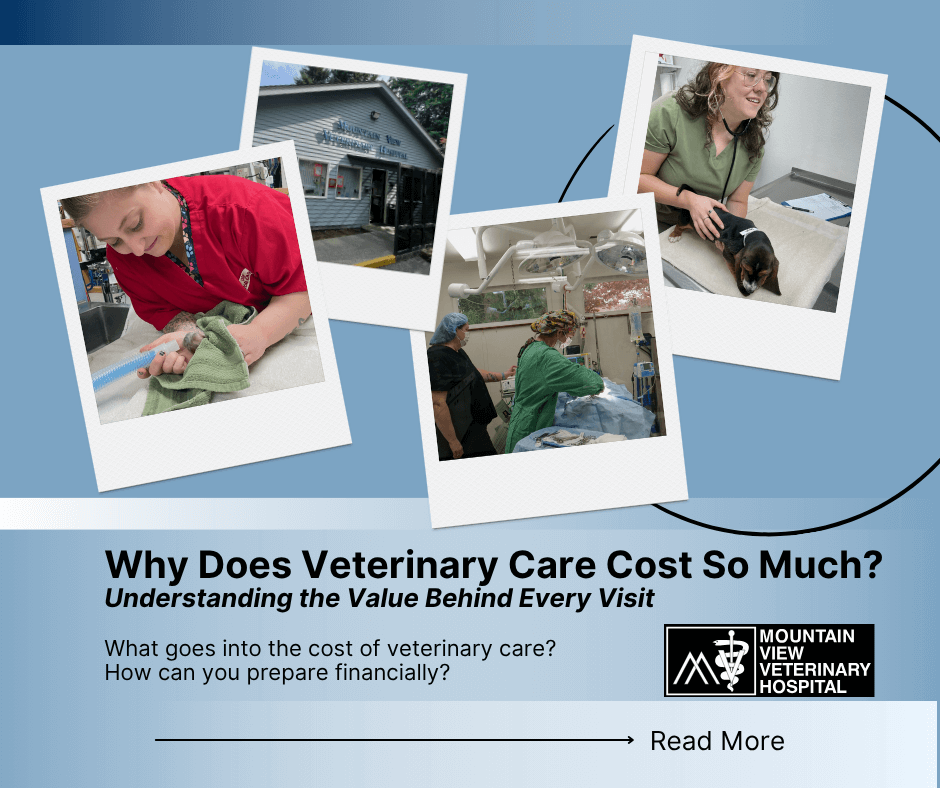
It’s a question we hear often: “Why is vet care so expensive?” We understand. As pet owners ourselves, we’ve been in those same difficult situations—facing a sick animal, a scary diagnosis, and the realization that doing what’s needed is going to cost a lot. It’s emotional, overwhelming, and often heartbreaking.
The truth is, the cost of veterinary care reflects the real resources, people, and infrastructure required to care for pets thoroughly and compassionately. Our goal here is to help you understand where those costs come from, how we calculate them, and what you can do to prepare for them because we want the best outcome for both you and your pet.
What Goes Into the Cost of Veterinary Care?
Veterinary hospitals are complex medical facilities that provide everything from diagnostics to surgery to intensive care. Unlike human medicine, there’s no government funding, Medicare or Medicaid reimbursements, or large insurance payouts helping to cover the cost. Here are some of the biggest contributors to the price of care at Mountain View:
Lab Services
Bloodwork and diagnostic testing are often performed by external laboratories, and veterinarians don’t set those prices. These labs require advanced equipment and highly trained personnel, which comes at a cost. Fast turnaround, accuracy, and specialty panels can drive up prices significantly.
Anesthesia and Surgery
Anesthesia isn’t just a single injection—it’s a complex, carefully monitored process that involves:
- Pre-anesthetic bloodwork
- Multiple medications for sedation, pain control, and induction
- Continuous monitoring of vital signs (like ECG, oxygen levels, and blood pressure)
- A trained staff member dedicated solely to your pet during surgery and recovery
This level of care means surgeries, whether routine or complex, require significant staff time, skill, and attention to detail.
Staff Time and Training
Our team is made up of compassionate, skilled professionals who do this work because they love animals. All of our veterinary technicians are licensed, having completed formal education and passed both national and state board exams. They also participate in continuing education to stay current in their field. Our assistants and client service representatives are likewise trained and dedicated to supporting patients and clients with care and compassion.
Even with all this expertise, veterinary professionals are often paid less than their counterparts in human medicine. Fair compensation is a necessary part of providing quality care and keeping great people in the field.
Medications, Fluids, and Supplies
Costs for veterinary medications and supplies are affected by inflation, shortages, and disruptions in the supply chain. Some items, like IV fluids, have become significantly more expensive after key manufacturing facilities were impacted by events like hurricanes. Even everyday medications can become harder to source, and we often have to pay more to maintain inventory for our patients.
Emergency Preparedness
Although Mountain View Veterinary Hospital is not a designated emergency facility, we do accept emergency cases when we are able. Being ready to respond means maintaining critical supplies like emergency medications, IV fluids, and specialized equipment, as well as ensuring our staff are trained in emergency protocols. These resources must be readily available at all times, even if they aren’t used every day. This level of preparedness is essential to offering comprehensive care and contributes to the overall cost of operating a full-service hospital.
As a high quality, full-service hospital, we implement all of the components mentioned above. Our pricing reflects the range and depth of care we provide. Each veterinary hospital is unique in the services it offers, the hours it keeps, and the size of its staff and these factors all influence the final cost of care. So, prices are not standard and can be different at each hospital.
A Personal Story
I want to share something personal because I’ve been there too. Not too long ago, my dog suddenly became very sick. He was vomiting, not eating, and bloodwork revealed dangerously high liver values. He had to be hospitalized for several days at an emergency hospital. His medications alone cost several hundred dollars, and even getting him to take them was a challenge. The hospital stay was over a thousand dollars which wiped out most of our savings.
On top of that, my family had to face the terrifying possibility that he might not survive. If we had needed to say goodbye, we still would’ve owed all that money. Thankfully, he recovered and is still with us, but it gave me a real, personal look at the emotional and financial stress so many of our clients face. Veterinary care is not like buying a product you can return if it doesn’t work out. The care, time, and effort go into every case, regardless of the outcome.
How You Can Prepare Financially
We want to help make veterinary care more manageable, and there are steps you can take to prepare:
- Pet Insurance: Start when your pet is young. Insurance doesn’t cover pre-existing conditions, so enrolling early gives you the most protection.
- Budget for Pet Care: Set aside a monthly amount in a savings account specifically for your pet’s needs.
- Medical Credit Options: Look into veterinary-specific credit options like CareCredit or Scratchpay.
- Charitable Organizations: There are nonprofits that help pet owners in crisis. Ask us if you need help finding resources.
We know it’s not easy. But being proactive can ease the burden when your pet needs care the most.
Veterinary care is a deeply personal and emotional experience—for both pet owners and veterinary teams. We hope this article helps shed some light on the costs involved and why they exist. At the end of the day, we all want the same thing: a healthy, happy life for the animals we love.
